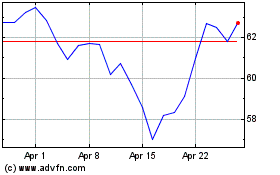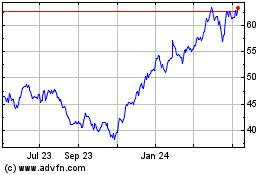By Liz Hoffman and David Benoit
For Americans checking their retirement accounts, the market's
swings during the first quarter were a horror show. For Wall
Street's traders, they were a windfall.
Big banks' trading desks posted their strongest results in years
during the first three months of 2020 -- when the deepening
coronavirus crisis wreaked havoc on the markets -- buying and
selling trillions of dollars worth of stocks and bonds, commodities
and interest-rate products.
Goldman Sachs Group Inc.'s debt traders had their best
three-month stretch in five years, pulling in nearly $3 billion.
Bank of America Corp.'s stock traders' $1.7 billion in revenue was
a quarterly record.
Those firms and others had to contend with traders working from
backup sites and from makeshift setups at home. The most volatile
conditions in years collided with a prohibition on congregating in
close quarters like trading floors.
Executives also had to balance the opportunity for profits with
the safety of staff. JPMorgan Chase & Co. was slow to act,
leading to a coronavirus outbreak on its Manhattan stock-trading
floor. Overall, the four major investment banks that have reported
quarterly results so far made $23 billion in trading revenue, 31%
more than the same period a year ago.
"March was the most extraordinary month of my career," said Jim
Esposito, a 25-year veteran of Goldman and co-head of its trading
arm. "We had both a spike in client volumes and spike in
volatility. That's a very potent combination that had been missing
for quite some time."
The results were one of the few bright spots in otherwise bleak
financial reports. Profit fell between 45%, at Bank of America, and
89%, at Wells Fargo & Co., after banks set aside billions of
dollars to cover expected losses on loans in what is likely to be a
painful recession. Morgan Stanley, slated to release results
Thursday, will be the last of the major U.S. banks to give a
first-quarter update.
The results show how Wall Street has changed since the financial
crisis. Today's banks carry smaller inventories of securities than
they once did. Wary of risk and regulatory snafus, they turn it
over more quickly and don't make the same proprietary bets they did
before the 2008 crisis.
Instead, they mostly stand in between clients who want opposite
sides of the same trade. In Wall Street speak, they "intermediate
risk."
That spared them from the worst of the declines in asset prices
and allowed them to profit by charging small fees on a surging
number of trades and lending hedge funds money to finance their own
positions.
While banks took huge trading losses in 2008 -- and many were
too weak to do much to help clients -- they are in stronger shape
today.
"People are desperate to be able to turn their portfolio over
and if you don't have to deal with your own issues, you are going
to do well." said Paco Ybarra, the head of Citigroup Inc.'s
institutional clients group.
The surge is unlikely to last, said Octavio Marenzi, chief
executive of Opimas, a consultant to financial-services companies.
"It was easy to make money" in the first quarter, he said, "but it
was, in all likelihood, a one-time hop. You often see this: Lots of
trading on the way down, but once you hit the bottom, it's dead
quiet."
Goldman's trading revenue rose 28% to $5.16 billion. Its
algorithmic group, which writes code to automatically buy and sell
securities, at one point was on pace to double its 2019 revenue,
according to a person familiar with the matter. Groups that help
clients wager and manage volatility in asset prices flourished,
too.
Coming into the year, Goldman had been easing up on the big bets
that once drove its trading profit, lowering both the size and
riskiness of its securities inventory. That proved lucky as the
pandemic hit, Chief Financial Officer Stephen Scherr said, leaving
the bank freer to jump into the market.
"We came into this crisis with a more manageable risk profile,"
he said. Goldman's total assets grew by 10% in the quarter, topping
$1 trillion, with much of the additional heft now sitting in its
trading operation.
Wall Street traders have complained for years about calm
markets, which depress the volume of trades and make it harder to
eke out profits on the ones that do come in. "Volatility wasn't
just low," Mr. Esposito said. "It had pretty much been
eliminated."
That changed in March.
Stock prices fell, then surged, and fell again. Wall Street's
"fear gauge," a measure of volatility, surpassed previous records
set in 2008. Debt investors started getting choosier about bonds,
charging far more to lend to lower-rated borrowers than safer ones,
after a decade of making little distinction.
Those market jumps opened up opportunities for the hedge funds
and other asset managers that are clients of big-bank trading
operations.
Banks "woke up and all of a sudden these hedge fund clients
started whipping it up like butter," said Bill Smead, chief
investment officer at Smead Capital Management Inc., which counts
JPMorgan and Bank of America among its largest holdings.
Bank of America's adjusted trading revenue rose 22% from a year
ago. Chief Financial Officer Paul Donofrio said clients flocked to
products that bet on the global economy, such as interest-rate
swaps and currency products. Trading in bonds and loans were weaker
at the firm, and its rivals, which had to revalue them to bake in
the growing risk of defaults.
At Citigroup, where trading revenue rose 39%, Mr. Ybarra said
the demand seemed to roll from one product to the next. In early
March, U.S. Treasurys -- and products that are tied to them -- were
going haywire. The Fed intervened to smooth that out, but other
corners of the market seized up.
JPMorgan posted a 32% rise in trading revenue, but also took a
$951 million loss on derivatives it held on its books.
The volatility struck as the banks, and their clients, were
forced to thin out their trading floors and send many employees
home or to alternate sites. Banks had to decide how many traders
could be remote and still keep the markets functioning -- and
profits flowing.
On April 2, just 30 Goldman Sachs traders, out of thousands,
were at its lower Manhattan headquarters. The floor was similarly
sparse at Citigroup, whose chief executive, Michael Corbat, said
the dislocation had led to fewer bumps that he anticipated.
"The plumbing is actually working pretty well," he said "We
probably all would've been skeptical" before the virus hit.
--Ben Eisen contributed to this article.
Write to Liz Hoffman at liz.hoffman@wsj.com and David Benoit at
david.benoit@wsj.com
(END) Dow Jones Newswires
April 15, 2020 18:56 ET (22:56 GMT)
Copyright (c) 2020 Dow Jones & Company, Inc.
Citigroup (NYSE:C)
Historical Stock Chart
From Mar 2024 to Apr 2024

Citigroup (NYSE:C)
Historical Stock Chart
From Apr 2023 to Apr 2024
